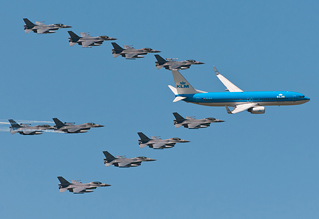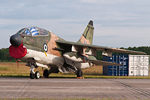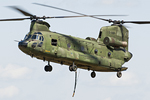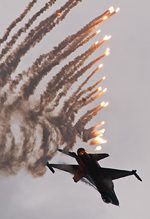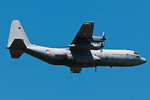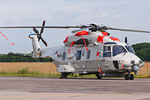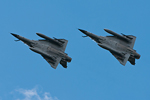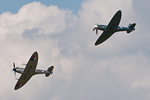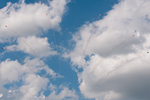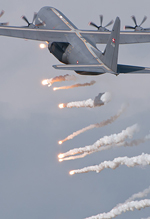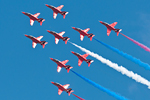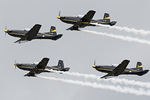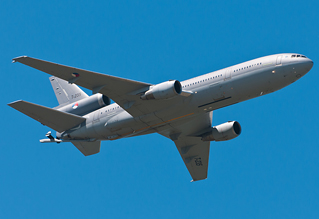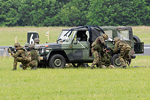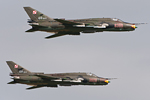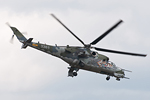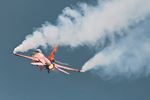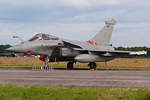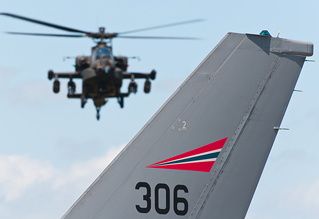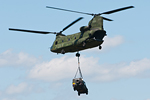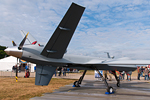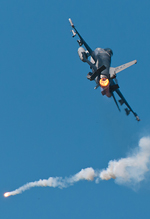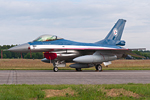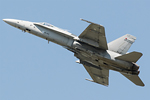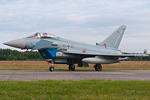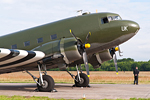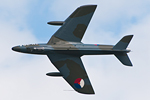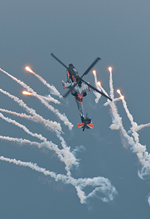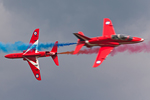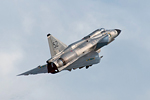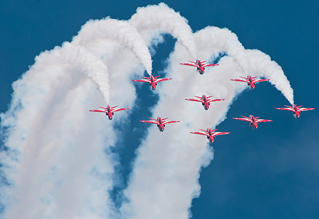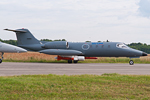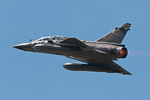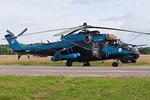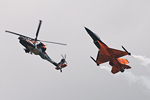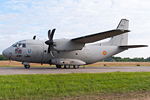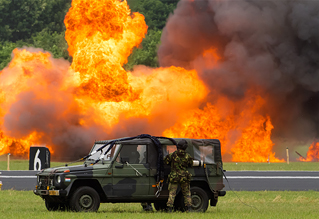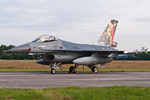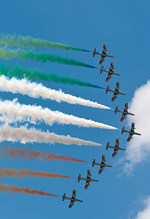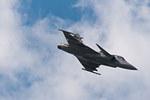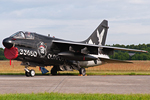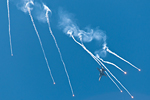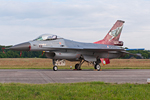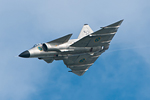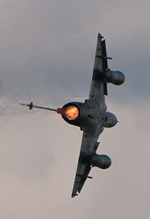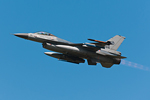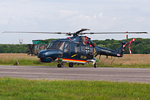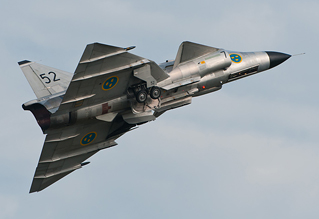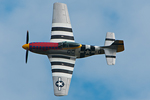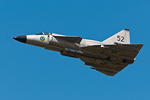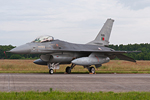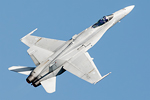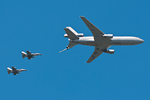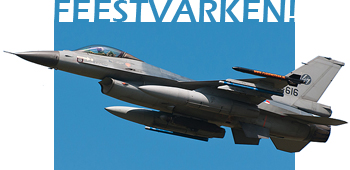
Volkel AB Luchtmachtdagen Report
Saturday 15th June 2013
During 2013 the Royal Netherlands Air Force, otherwise known as the Koninklijke Luchtmacht (KLu for short), are celebrating 100 years of military aviation in the Netherlands. It was only fitting that one of the highlights of the celebrations would be the annual KLu Open Dagen which was this year held at Volkel Air Base near Uden. Held over two days, the annual Open Dagen is a free to enter airshow designed to show the public their air force together whilst acting as a valuable recruitment tool.
Braving extremes of weather, joined the "Birthday Boy" for the final day of the Open Dagen. Additional photos from .
The Dutch are immensely proud of their air force and rightly so, it is one of the oldest military aviation branches in the world and has had a diverse history. In April 1913, Queen Wilhelmina of the Netherlands signed an order for an aviation department to be formed within the Dutch Army, to be known as the Luchtvaartafdeling (LVA for short). The LVA took delivery of its first and only aircraft, a "De Brik" during July 1913. The aircraft was a leased improved model of the Farman which proved so successful that it was eventually purchased and joined by further aircraft. The beginnings of a Dutch Air Force were born. Shortly before the outbreak of World War Two, the LVA were renamed to the Wapen der Militaire Luchtvaart.
At the outbreak of hostilities in Europe the Netherlands intended to remain neutral and as a result were ill-prepared for the German Invasion. At the beginning of the invasion, the WML had just 110 combat aircraft and were outnumbered by a ratio of over 10:1 by the Luftwaffe. Surviving Dutch units fled to the UK and fought alongside the RAF for the majority of the war. In addition, an independent branch of the Dutch Military in the Dutch Indies continued to fight until they were overwhelmed by the Japanese; many surviving units joined the Australian military.
In 1944, the Directoraat der Nederlandse Luchtstrijdkrachten (DNLSK) was formed in London creating the first independent Dutch Air Force separate from the Army. As part of its formation, all Dutch pilots flying for the RAF were transferred together with their equipment. Following the end of the War, the DNLSK returned to active airfields in the Netherlands in 1946 and recommenced training operations in 1947. In March 1953, following a decision by the then Queen Juliana, the DNLSK were renamed and became the modern KLu. Since then, the KLu has gone from strength to strength operating some of the most iconic aircraft types within NATO including the Gloster Meteor, F-84 Thunderjet, F-104 Starfighter and F-16 Fighting Falcon. The KLu continue to perform on the world stage and are currently deployed to Afghanistan.
Volkel Air Base provides some unique challenges for photography that are rarely experienced at other venues. Due to the layout of the base, the static aircraft are parked together with some of the display aircraft directly in front of the main crowd line. Why does this provide a challenge? Well firstly everyone, including those wanting to look at the static aircraft, are jostling for position to get a good look making the entire crowd line very crowded. Secondly, getting effective photos of aircraft that are low or departing/arriving are virtually impossible due to the static aircraft being in the way. On the plus side, the sun is behind you most of the day providing ideal photographic conditions.
Due to the 100th anniversary, expectations were high for the 2013 Open Dagen, it was clear that the organisers were keen not to disappoint. The Saturday show saw some extremes of weather which certainly did it's best to provide a challenge. The day started with overcast skies which quickly gave way to a relatively short period of extremely heavy rain. Kudos must go to Solo Turk who put on a very brave display in monsoon conditions whilst the crowd ran for cover. Soon the rain abated and gave way to sunshine and blue skies.
The static line up had a number of very special participants. Representing neighbouring Germany, the Luftwaffe sent a pair of Typhoons which were accompanied by the beautiful blue and gold 'Phantom Pharewell' F-4F. In addition, the Greek Air Force sent two examples of the rarest aircraft on the European airshow scene, the A-7 Corsair II. One of which was painted in a gorgeous black and silver scheme. Joining the special paint display was Norway's F-16 resplendent in its blue, white, red and silver scheme. Great to see but disappointing not to see it displaying in the air. Not to be outclassed, the home team displayed the specially painted F-16s from 322Sqn and 323Sqn.
The static wasn't just limited to fast jets, a myriad of Dutch and foreign transports were also on display ranging from a Romanian C-27J to a Slovakian AN-26 and from a NATO E-3A and a Hungarian operated NATO C-17A. Sadly the C-17 was badly parked and was backlit for the majority of the day with no way to get to the other side of the aircraft. Perhaps the most significant static participant was surprisingly a Predator B UAV. Why was this significant? This was a static aircraft from the USAF on a year when they have cancelled all participation at airshows due to sequestration. To hide that the Predator was USAF, every visible marking (including the serial) had been removed. Surely it isn't a coincidence that Fokker have announced a joint venture with General Atomics to market the Predator B to the KLu at the Paris Airshow the following week after the Open Dagen?
The flying display consisted of no less than eight fast jet displays of various shapes and sizes. All the fighters used flares bar the superbly noisy Viggen and brilliantly dynamic Mirage 2000N "Ramex Delta" duo. Of the fast jet displays, the Viggen and Ramex Delta displays stood out as high quality acts that would go down a storm at a UK airshow. Sadly, the Polish Su-22 demo display seems significantly dumbed down compared to the 2012 display with a shorter, slower display and significantly fewer flares being used, a sign of the times? The European display teams were well represented with the presence of the Patrouille de France, Frecce Tricolori, Patrouille Suisse and the Red Arrows.
Of the modern international solo displays, by far the most surprising was a rare display by a C-130J-30 from the Royal Danish Air Force. In its UK guise at say, RIAT, the display would be deemed as boring with two circuits followed by a fast pass. However, it is the end of the fast pass that has the wow factor, the aircraft pulls up hard whilst deploying well over 100 flares in an arc. In addition, a much more subdued display than previous years was performed by the tiger tailed Czech Mi-24 Hind whilst a royal blue Hind sat in static.
The highlight of any Open Dagen is the air power demo sequence. This year taking part were 10 F-16s (one with an AZ tail after recently returning from Arizona), a KDC-10, C-130H-30, 2 AH-64Ds and 2 CH-47Ds. The sequence involves lots of passes by all aircraft, plenty of explosions and plenty of flares. The annual air power demo is on a par with anything Yeovilton has ever displayed and makes the RAF role demo of a few years back look tiny. On the Saturday the air power demo ended with a very special flypast. The 10 F-16s performed a top side pass in close formation with a Boeing 737. Why was this so special? The aircraft was donated by KLM and the crew volunteered to fly a passenger manifest of chronically ill and handicapped children, giving them an experience they will never forget.
As this was a 100 year celebration, the history of the KLu was also displayed to the crowd. The lunchtime segment consisted of a number of formation displays by warbirds and transport aircraft that have been operated over the years by the different incarnations of the KLu. In order to mark the close relationship between the KLu and RAF, the BBMF flew one of their Spitfires in a formation display with the Royal Netherlands Historic Flights Spitfire. The finale to the flying display was a historic formation celebrating early jet aircraft in the Netherlands. Joining the Klu display F-16 was the Dutch Hawker Hunter and Classic Air Force Meteor T7 for a unique flypast. A rare photographic opportunity.
Open Dagen 2013 was a huge success with a crowd of 220,000 visitors over the two days. Open Dagen 2014 is currently scheduled to take place during the 20th and 21st June 2014 at Gilze-Rijen Air Base. Gilze-Rijen is arguably the best venue the KLu use for the Open Dagen in terms of photography and layout, it last held the show in 2010. Can they build on the success of 2013? We certainly hope so!
